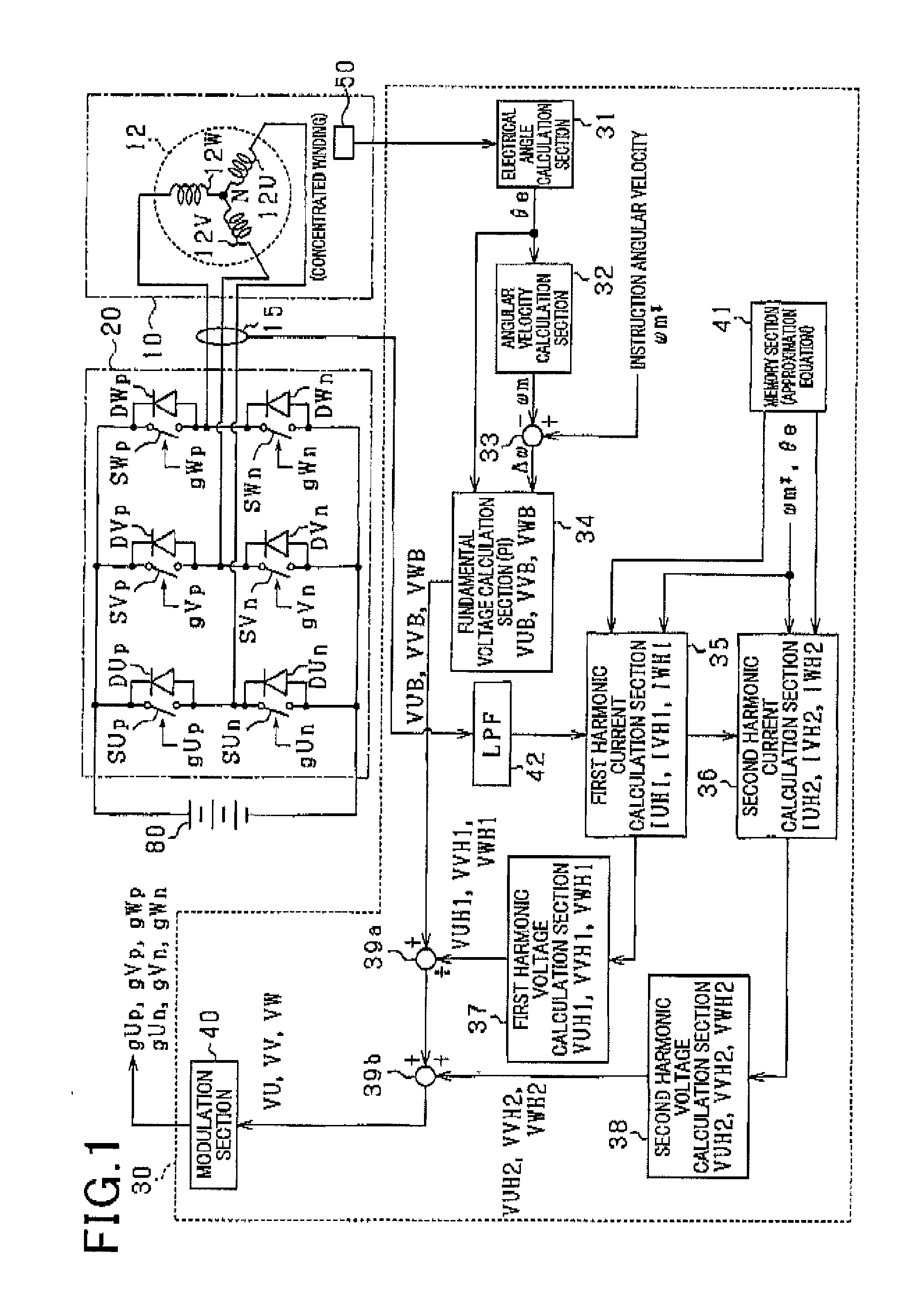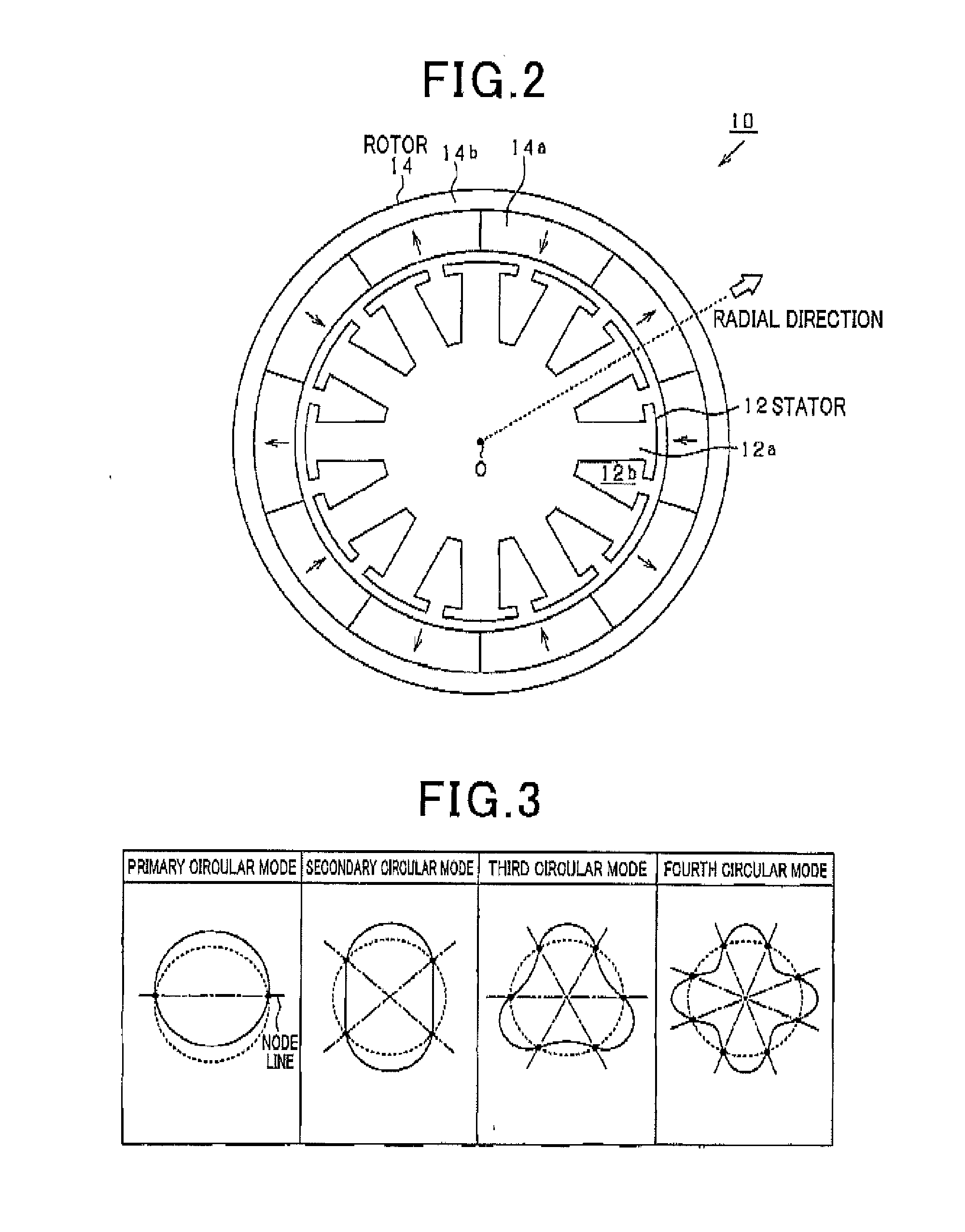Control device for rotating electric machine
a technology of control device and electric machine, which is applied in the direction of machines/engines, mechanical equipment, and electric commutators, etc., can solve the problems of difficult to effectively eliminate difficult to correctly reduce electromagnetic force, and difficult to effectively reduce etc., to achieve the effect of reducing electromagnetic force components causing nois
- Summary
- Abstract
- Description
- Claims
- Application Information
AI Technical Summary
Benefits of technology
Problems solved by technology
Method used
Image
Examples
first exemplary embodiment
[0044]A description will be given of the control device 30 for a rotating electric machine according to the first exemplary embodiment with reference to FIG. 1 to FIG. 7.
[0045]FIG. 1 is a view showing a schematic structure of a rotating electric machine system (or the motor system) having the control device 30 according to the first exemplary embodiment. The motor system shown in FIG. 1 is the in-vehicle A / C system. The in-vehicle A / C system has the control device 30, the blower motor 10 (hereinafter, the motor 10) as a rotating electric machine, an inverter 20, a current sensor 15 and a rotation angle sensor 50.
[0046]The motor 10 is a permanent magnet synchronous motor of three phase concentrated windings (hereinafter, three phase windings). The inverter 20 receives and converts a direct current electric power (DC electric power) supplied from a battery 80 as a direct current power source to an alternating current electric power (AC electric power). The motor 10 rotates when receiv...
second exemplary embodiment
[0131]A description will be given of the control device 30 according to the second exemplary embodiment with reference to FIG. 8 to FIG. 10.
[0132]As previously described, the first exemplary embodiment uses the suppression range of electromagnetic force from L-th order to (N−2)-th order which is larger than L-th order, and odd numbered harmonic currents within the suppression range of L-th order to N-th order are superimposed over the fundamental current, and these order electromagnetic force components are converted to the N-th electromagnetic force component. In particular, the first exemplary embodiment uses the (6M−2)-th electromagnetic force component and the 6M-th electromagnetic force component within the suppression range, and the (6M−1)-th harmonic current and the (6M+1)-th electromagnetic force component are superimposed over the fundamental current in order to convert the electromagnetic force within the suppression range to the (6M+2)-th electromagnetic force component.
[...
third exemplary embodiment
[0149]A description will be given of the control device 30A according to the third exemplary embodiment with reference to FIG. 11 to FIG. 16.
[0150]The control device 30A according to the third exemplary embodiment performs a method of calculating harmonic currents to be superimposed over the fundamental current, which is different from the method performed by the control device 30 according to the first exemplary embodiment previously described. That is, the control device 30A uses the suppression range including the (6M−2)-th electromagnetic force component and the 6M-th electromagnetic force component. The control device 30A superimposes the (6M−1)-th harmonic current and the (6M+1)-th harmonic current over the fundamental current.
[0151]In particular, the third exemplary embodiment will explain the case of M=2. The control device 30A uses the eleventh harmonic current as the primary harmonic currents IHU1, IHV1 and IHW1, and the twelfth harmonic current as the secondary harmonic c...
PUM
 Login to View More
Login to View More Abstract
Description
Claims
Application Information
 Login to View More
Login to View More - R&D
- Intellectual Property
- Life Sciences
- Materials
- Tech Scout
- Unparalleled Data Quality
- Higher Quality Content
- 60% Fewer Hallucinations
Browse by: Latest US Patents, China's latest patents, Technical Efficacy Thesaurus, Application Domain, Technology Topic, Popular Technical Reports.
© 2025 PatSnap. All rights reserved.Legal|Privacy policy|Modern Slavery Act Transparency Statement|Sitemap|About US| Contact US: help@patsnap.com



